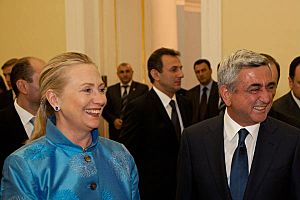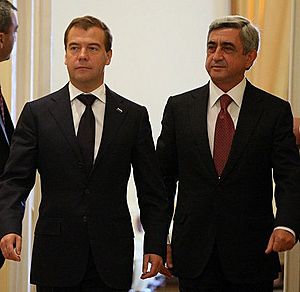Serzh Sargsyan facts for kids
Quick facts for kids
Serzh Sargsyan
|
|
|---|---|
| Սերժ Սարգսյան | |

Official portrait, 2013
|
|
| 3rd President of Armenia | |
| In office 9 April 2008 – 9 April 2018 |
|
| Prime Minister | Tigran Sargsyan Hovik Abrahamyan Karen Karapetyan |
| Preceded by | Robert Kocharyan |
| Succeeded by | Armen Sarkissian |
| 11th and 15th Prime Minister of Armenia | |
| In office 17 April 2018 – 23 April 2018 |
|
| President | Armen Sarkissian |
| Preceded by | Karen Karapetyan (Acting) |
| Succeeded by | Karen Karapetyan (Acting) |
| In office 4 April 2007 – 9 April 2008 Acting: 25 March 2007 – 4 April 2007 |
|
| President | Robert Kocharyan |
| Preceded by | Andranik Margaryan |
| Succeeded by | Tigran Sargsyan |
| Minister of Defence | |
| In office 20 May 2000 – 26 March 2007 |
|
| Prime Minister | Andranik Margaryan |
| Preceded by | Vagharshak Harutiunyan |
| Succeeded by | Mikael Harutyunyan |
| In office 21 August 1993 – 17 May 1995 |
|
| Prime Minister | Hrant Bagratyan |
| Preceded by | Vazgen Manukyan |
| Succeeded by | Vazgen Sargsyan |
| Minister of Interior and National Security | |
| In office 4 November 1996 – 11 June 1999 |
|
| Prime Minister | Armen Sarkissian Robert Kocharyan Armen Darbinyan |
| Preceded by | Vano Siradeghyan |
| Succeeded by | Suren Abrahamyan |
| Personal details | |
| Born |
Serzhik Azati Sargsyan
30 June 1954 Stepanakert, Nagorno-Karabakh Autonomous Oblast, Soviet Union |
| Political party | Communist Party (?–1988) Pan-Armenian National Movement (1989–?) Republican Party (2006–present) |
| Spouse | |
| Children | 2 |
| Residence | Dzoraghbyur |
| Alma mater | Yerevan State University |
| Signature | |
| Military service | |
| Allegiance | |
| Branch/service | Soviet Army Nagorno-Karabakh Defense Army |
| Years of service | 1972–1974 1989–1992 |
| Battles/wars | First Nagorno-Karabakh War |
Serzh Azati Sargsyan (born 30 June 1954) is an Armenian politician. He served as the third President of Armenia from 2008 to 2018. He was also the Prime Minister of Armenia twice, from 2007 to 2008, and again for a short time in April 2018. He stepped down from his prime minister role in 2018 after large public protests.
Sargsyan won the presidential election in February 2008. He had the support of the Republican Party of Armenia, where he was the chairman. He became president in April 2008. In February 2013, he was re-elected and served his full term.
In 2014, Sargsyan said he would not become prime minister again. However, after a change to the constitution in 2015, he was elected prime minister in April 2018. Some people in the opposition said this was an attempt to hold onto power. Just six days after becoming prime minister, Sargsyan resigned because of big protests. He is currently the leader of the Republican Party. This party was in charge of Armenia from 1999 to 2018. Now, it is part of the opposition in parliament.
Contents
Early Life and Education
Serzh Sargsyan was born on 30 June 1954 in Stepanakert. This city was in the Nagorno-Karabakh Autonomous Oblast at the time. His parents were Azat Avetisi Sargsyan and Nora Sargsyan. His father's family came from the village of Tegh in the Armenian SSR. They moved to Stepanakert after his grandfather faced difficulties in 1937.
Sargsyan started studying at Yerevan State University in 1971. He served in the Soviet Armed Forces from 1971 to 1972. In 1975, he began working at the Electrical Devices Factory in Yerevan. He finished his studies in Philology at Yerevan State University in 1979. In 1983, he married Rita (née Dadayan). Besides Armenian, he speaks Russian and also knows Azerbaijani. He is not related to former Prime Minister Tigran Sargsyan or former President Armen Sarkissian.
Political Journey
Starting His Career
From 1979, Sargsyan held several roles in the Stepanakert Komsomol Committee. He started as a division head and later became the first secretary. His long-time political friend, Robert Kocharyan, was his deputy. After that, he worked in the Stepanakert City Committee. He also served as an instructor for Communist Organizations in the Nagorno-Karabakh Regional Committee. Finally, he became an assistant to Genrikh Poghosyan, the First Secretary of the Nagorno-Karabakh Regional Committee.
In November 1989, Sargsyan was a representative from Nagorno-Karabakh. He attended the first meeting of the Pan-Armenian National Movement. In 1990, he was elected to the Supreme Council of Armenia.
Role in the Nagorno-Karabakh War
During the First Nagorno-Karabakh War, Sargsyan helped organize the defense of Nagorno-Karabakh. He also helped create the NKR Defense Army. In January 1992, when the first government of the Nagorno-Karabakh Republic (NKR) was formed, Sargsyan became the head of the Defense Committee. He held this position until August 1992. Then, he became a member of the seven-person State Defense Committee of the NKR. This committee was like the government of the NKR. Sargsyan served as the minister of the army within this committee.
Government Positions
From 1993 to 1995, he was Armenia's Minister of Defense. This was under President Levon Ter-Petrosyan. In 1995, he became Minister of National Security of Armenia. From 1996 to 1999, he was also the Minister of Interior at the same time. In February 1998, Sargsyan, along with Prime Minister Robert Kocharyan and Defense Minister Vazgen Sargsyan, pushed President Ter-Petrosyan to resign. They did this to stop him from accepting a peace plan for the Nagorno-Karabakh conflict. This plan would have returned most of the Armenian-controlled lands around Nagorno-Karabakh to Azerbaijan.
From 1999 to 2000, he worked as the Chief of Staff for President Robert Kocharyan. Then, he served as the Defense Minister of Armenia again from 2000 to 2007. He was also the Secretary of the National Security Council from 1999 to 2007. On 4 April 2007, Sargsyan was appointed Prime Minister after the sudden death of Andranik Margaryan.
Presidential Election
Sargsyan was seen as the strongest candidate for president in the 2008 Armenian presidential election. He had the support of President Kocharyan. The first results showed he won about 53% of the votes. This was enough to win in the first round, far ahead of Levon Ter-Petrossian. International observers said the 2008 election was largely democratic.
However, Ter-Petrosyan's supporters disagreed with the results. They held large protests in Yerevan for over a week. These protests turned violent on 1 March, and some people lost their lives. A state of emergency was declared for 20 days.
Presidency (2008–2018)
Serzh Sargsyan became president on 9 April 2008. He spoke about the "painful events" after the election. He asked everyone to "look forward" and find a way for "reconciliation, development, and future of Armenia." He chose Tigran Sargsyan, who was the Chairman of the Central Bank, as Prime Minister. Tigran Sargsyan was not part of a political party.
During Sargsyan's time as president, the government worked to fight corruption. New rules and stronger enforcement led to more lawsuits against officials. Armenia's corruption rating improved. Freedom of speech and press also got better. More people started using the internet, which gave them more access to online news. The number of bloggers also grew a lot.
After the elections, Sargsyan allowed opposition rallies in Yerevan. He promised to follow the Council of Europe's requests to stop the government's actions against the opposition. Civil society also grew, with more non-governmental organizations. These groups worked on human rights, protecting the environment, and social fairness.
Economy
Sargsyan's presidency started during the Great Recession. In 2009, Armenia's economy shrank by over 14%. This was one of the worst declines in the world that year. After that, the economy grew steadily by about 3% until 2013. However, by 2014, Armenia's economy was still smaller than before the crisis. During his first term, the number of people living in poverty doubled.
In September 2013, Sargsyan announced Armenia's plan to join the Eurasian Economic Union. This union included Belarus, Kazakhstan, and Russia. The Eurasian Economic Union (EAEU or EEU) started on 1 January 2015. Armenia officially joined on 2 January 2015. The EEU has a large single market of 176 million people. It allows goods, money, services, and people to move freely between member countries.
Foreign Relations
Nagorno-Karabakh
Sargsyan spoke at the United Nations General Assembly in September 2008. He talked about the 2008 South Ossetia conflict. He stressed that the UN should help solve conflicts peacefully, including the one in Nagorno-Karabakh. He also warned that Azerbaijan's military buildup and threats could cause new problems in the region.
Sargsyan continued to work for a peaceful solution to the Nagorno-Karabakh conflict. He said Armenia wanted a fair and peaceful solution. He believed the OSCE Minsk Group was the right place for peace talks. He met with the president of Azerbaijan, Ilham Aliyev, several times. In November 2008, they signed a declaration to continue talks. They met again in 2009.
Sargsyan said Azerbaijan was making the peace process difficult. He pointed to Azerbaijan's policies against Armenians, like changing history and hostile messages. He said these actions showed Azerbaijan did not want peace. He also mentioned the case of Ramil Safarov. Safarov had committed a serious crime against an Armenian officer. After being sent back to Azerbaijan, he was pardoned and seen as a hero. Sargsyan said this showed that "Azeri propaganda raises a whole generation in an atmosphere of hatred and not accepting others."
Sargsyan clearly stated that Nagorno-Karabakh has no future within Azerbaijan. He said Azerbaijan has no legal or moral right to claim Nagorno-Karabakh. He also said that a solution should be based on human rights and the will of the people of Karabakh. He believed forcing Karabakh people back into Azerbaijan would lead to new ethnic cleansing.

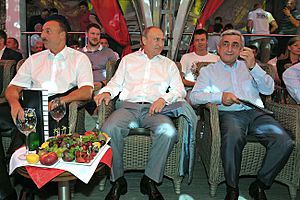
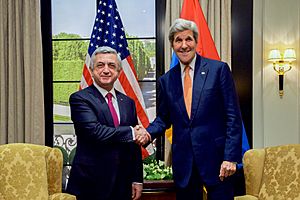

Sargsyan condemned Azerbaijan's constant threats of war. He said it broke international law because both sides had signed a truce. He repeatedly said Armenia did not want war but was ready to defend itself. In 2014, Sargsyan stated, "We don't want war and never wanted, but at that time we had to defend our Motherland. If the time comes again, this time our blow will be final and deadly."
He also said that if Azerbaijan started a military attack, Armenia would have to officially recognize the Nagorno-Karabakh Republic. Armenia would then use all its power to protect the people of Artsakh.
Sargsyan met with Ilham Aliyev in Russia in June 2011. They almost reached an agreement. The plan involved Armenia returning some land to Azerbaijan. In return, Nagorno-Karabakh would get a temporary status, and international peacekeepers would be sent. The final status of the region would be decided later by a vote. However, Azerbaijan rejected these proposals.
In his 2013 election plan, Sargsyan promised to make Nagorno-Karabakh and its people safer. He also stressed the importance of strengthening Armenia's defense. He wanted to ensure Karabakh became a part of the peace talks. He also aimed to build stronger ties between Karabakh and the rest of the world.
In April 2016, Sargsyan led Armenia through the 2016 Nagorno-Karabakh conflict. This was the biggest outbreak of fighting since the 1994 ceasefire. The four days of fighting resulted in many deaths and some land loss. Sargsyan called the outcome a victory for Armenia. However, he faced criticism for problems during the fighting.
Later, in July 2016, a group of armed men took over a police building in Yerevan. They demanded Sargsyan's resignation. This event, along with large protests, ended when the gunmen surrendered.
After the 2020 Nagorno-Karabakh war, Sargsyan said he wanted to find a final solution to the conflict. He said this was why he decided to stay as prime minister in 2018. He denied delaying the talks or saying that no land could be given to Azerbaijan. He added that he was "ready to be called a traitor, but resolve the [Nagorno-Karabakh] question."
Turkey
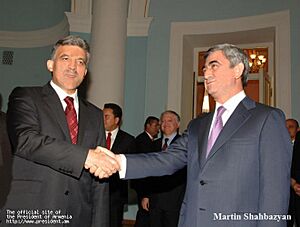
When he became president in 2008, Sargsyan promised to work on improving relations with Turkey. He wanted to normalize ties without any conditions. He also continued to seek international recognition for the 1915 Armenian genocide.
Sargsyan took steps to improve relations with Turkey, a policy called "football diplomacy." In 2008, he invited Turkish President Abdullah Gül to Armenia. They watched a football match between Armenia and Turkey. Sargsyan later visited Turkey for the return match.
On 10 October 2009, Armenia and Turkey signed agreements to start diplomatic relations. This was done without any conditions. The agreement also meant opening the border between the two countries, which Turkey had closed in 1993. The agreements were signed in Geneva, Switzerland, with international help, mainly from the United States.
Sargsyan's policy to improve relations with Turkey received mixed reactions in Armenia. Some people supported opening the border and increasing trade. Others worried that Armenia would have to make big compromises to Turkey. Important Armenian opposition parties were strongly against signing the agreements. They thought it was a betrayal.
The process of improving relations stopped after a year. In Armenia, the agreements were sent to the Constitutional Court for approval. The Court said that the agreements did not mean Armenia officially recognized the existing Turkish-Armenian border. This was a key part of the agreements. Turkey saw this as changing the agreements and pulled back from the process. As a result, the Turkish Parliament did not approve the agreements. Armenia accused Turkey of linking the process to the Nagorno-Karabakh conflict. Sargsyan explained the halt by saying Turkey had used "preconditions" and tried to "protract time and fail the process." He said Armenia considered the current phase of normalization "exhausted."
However, Sargsyan also stated that Armenia remains committed to improving relations with Turkey, unlike Ankara.
European Union
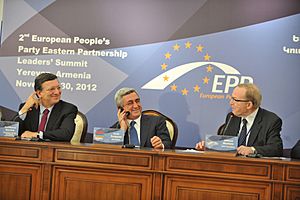
President Sargsyan supported Armenia's efforts to sign an Association Agreement with the EU. This agreement included a Deep and Comprehensive Free Trade Area. Negotiations for the agreement were finished, and Armenia was ready to sign it. However, in September 2013, Sargsyan changed his mind. After meeting with President Vladimir Putin in Moscow, he decided to join the Russian-led Eurasian Economic Union. Many believed that Russia's pressure caused this change.
Even with this change, Sargsyan's government worked on EU-inspired reforms in law and governance. This led to Armenia signing the Comprehensive and Enhanced Partnership Agreement with the European Union on 24 November 2017. Russia approved Armenia signing this deal after economic parts were removed.
Protests Against Sargsyan
Major protests against Sargsyan's government started in 2011. His rival from the 2008 election, Levon Ter-Petrossian, led them. In response, Sargsyan said in April 2011 that the government would fully investigate the violence that followed the 2008 election.
In July 2016, thousands of Armenians protested in Yerevan. They supported an armed group that took over a police building. This group called for the release of political prisoners and Sargsyan's resignation. The National Security Service called it a terrorist attack. However, many Armenians disagreed.
Prime Minister (2018)
Shortly after his presidency ended on 9 April 2018, Sargsyan was elected Prime Minister of Armenia on 17 April. Opposition leaders called this an attempt to stay in power. There were large protests against him. On 22 April, Sargsyan met with opposition leader Nikol Pashinyan. Sargsyan said the opposition was giving an ultimatum instead of talking. He left the meeting early, and Pashinyan was arrested hours later.
The protests continued and eventually pressured Sargsyan. On 23 April, Pashinyan was released, and Sargsyan announced his resignation. Former Prime Minister Karen Karapetyan took over as acting Prime Minister. Armenia's National Assembly, still controlled by Sargsyan's party, elected Nikol Pashinyan Prime Minister on 8 May 2018.
Awards and Honors
Serzh Sargsyan has received several honors:
- Order of first Degree "Martakan Khach" ("Combat Cross") (Armenia, 1994)
- Hero of Artsakh (Republic of Artsakh, 2000)
- Order of "Voske Artsiv" (Golden Eagle) (Republic of Artsakh, 2000)
- Order of "Tigran Mets" (named after Tigranes the Great) (Armenia, 2006)
- Order of Honor (Georgia, 2010)
- Grand Cross of the Legion of Honour (France, 2011)
- The First Class of the Order of Prince Yaroslav the Wise (Ukraine, 2011)
- Order of the Republic of Serbia (2013)
- Presidential Order of Excellence (Georgia, 2013)
- National Order of Merit (France, 2014)
- Order of the Golden Fleece (Georgia)
Personal Life
In 1983, Serzh Sargsyan married Rita Sargsyan (née Dadayan). They had two daughters, Anush and Satenik. They also have two granddaughters, Mariam and Rita, and two grandsons, Ara and Serzh. Sargsyan is also the chairman of the Armenian Chess Federation. His wife Rita passed away on 20 November 2020, at the age of 58.
Sargsyan has two younger brothers. Alexander (Sashik) is a businessman and a former member of Armenia's parliament. Levon is a diplomat and a professor at Yerevan State University.
Images for kids
See also
 In Spanish: Serzh Sargsián para niños
In Spanish: Serzh Sargsián para niños


